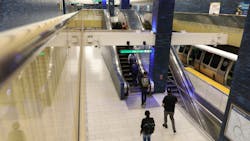BART releases 2022 Sustainability Report
Bay Area Rapid Transit (BART) released its 2022 Sustainability Report, which focused on BART's green energy and modernization efforts to provide alternate regional travel away from automobiles.
"Today, BART is one of the greenest options for Bay Area residents traveling around the region," said BART General Manager Bob Powers in his introductory message to the report. "Every time you ride rather than drive, you're helping to reduce regional pollution and support sustainability."
According to BART, Riders who take the public transit system daily for one month emit less carbon dioxide than those driving to the same location just once. A BART rider gets 73.3 miles per gallon, which on average is three times more efficient than a typical car driven alone.
BART celebrated its 50th year of serving the Bay Area in 2022, and the Sustainability Report emphasizes BART's five decades of sustainability efforts. From its inception in the 1950s, BART's founders prioritized central locations in the Bay Area to "provide convenient service within walking distance", which has enabled BART’s Transit-Oriented Development program to build housing and commercial spaces next to transit hubs. From the onset, BART was designed to run electric trains, which produce no emissions or pollution at point of use. Since 2020, core BART trains are powered by 100 percent greenhouse gas-free sources from a diverse mix of hydroelectric, wind and solar generation.
In 2022, BART also recorded its lowest total energy use and potable water use since it began tracking these metrics in 2015. BART's total greenhouse gas emissions dropped 92 percent in 2022 compared to 2015, meaning it has already achieved its 2025 target goals.
In the report, BART highlights its progress in modernization of infrastructure, such as trains, stations, and parking garages. Modernization projects were completed at 19th St. and Powell Street stations, improving the rider experience and saving energy by using LED lighting and new underground restrooms with water-efficient fixtures. BART's new lighting at the two stations also conserves more than 510,000 kWh annually -- equivalent to the annual electricity usage of about 48 homes in the U.S. BART also upgraded more than 10,500 lighting fixtures across 14 parking garages, switching from dated metal halide and sodium-vapor fixtures to brighter and more energy-efficient LED lights, which require less maintenance. In addition to making park-and-ride BART patrons feel safer, the project is estimated to save nearly 7.8 million kWH each year or equivalent to the annual electricity use of 730 U.S. homes.
Climate change is on the forefront of BART's sustainability efforts, as the Bay Area has seen record wildfires in recent years. In 2022, BART took two major steps to advance its climate resiliency. The first was updating BART's Local Hazard Mitigation Plan, a planning document that identifies the risks of natural hazards -- flooding, rising sea levels, extreme heat, and wildfires, among others -- and actions for reducing these risks. Examples of such actions include seismic retrofits, slope stabilization and erosion control and fire protection replacement.
The second step was endorsing the Bay Adapt Joint Platform, a regional strategy addressing how the Bay Area will adapt to rising sea levels. The BART Board of Directors joined 55 other Bay Area cities, counties and organizations in support of regional adaptation to sea level rise.
BART recognizes its constant interaction with the wildlife that surrounds its stations and employs natural and humane methods to manage critters found throughout our system. BART hired a falconer to mitigate pigeons at some BART stations and has long contracted a local beekeeper to remove beehives found in the system. During summer months, BART hires goats (and sheep this year) to graze on dry vegetation sprawled across the hills and fields next to BART right-of-ways to reduce wildfire risk.
The 2022 Sustainability Report can be found here.
